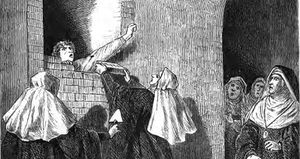Immurement
Immurement is a form of execution where a person is walled up within a building and left to die from starvation or dehydration. This is distinct from a premature burial, where the victim typically dies of asphyxiation.
In legend and folklore
According to Finnish legends, a young maiden was wrongfully immured into the castle wall of Olavinlinna as a punishment for treason. The subsequent growth of a rowan tree at the location of her execution, whose flowers were as white as her innocence and berries as red as her blood, inspired a ballad.
Similar legends are known (e.g., from Haapsalu, Kuressaare and Visby).
The folklore of many Southeastern European peoples refer to immurement as the mode of death for the victim sacrificed during the completion of a construction project, such as a bridge or fortress. Many older Bulgarian and Romanian folk songs describe a bride offered for such purposes, and her subsequent pleas to the builders to leave her hands and breasts free, that she might still nurse her child. Later versions of the songs revise the bride's death; her fate to languish, entombed in the stones of the construction, is transmuted to her nonphysical shadow, and its loss yet leads to her pining away and eventual death.
Other variations include the Hungarian folk ballad "Kőmíves Kelemen" (Kelemen the Stonemason). This tale relates twelve unfortunate stonemasons tasked with building the (real) fort called Déva in Poland (1269–1848). To remedy its recurrent collapses, it is agreed that one of the builders must sacrifice his bride, and the bride to be sacrificed will be she who first comes to visit. Some versions of the ballad treat her relatively kindly by first burning the bride before building her ashes into the wall rather than walling her up alive.
A similar Romanian legend, also mixing truth and fantasy, tells of the fictional architect Meşterul Manole, who must sacrifice his wife to build the very real Curtea de Argeş Monastery.
A parallel Greek story (Greek: Το Γεφύρι της Άρτας, English: The Bridge of Arta) describes numerous failed attempts to build a bridge in the city of Arta. A cycle whereby a team of skilled builders would toil all day only to return the next morning to find their work demolished was eventually ended when the master mason's wife was immured.
See also Oubliette
Chat rooms • What links here • Copyright info • Contact information • Category:Root
